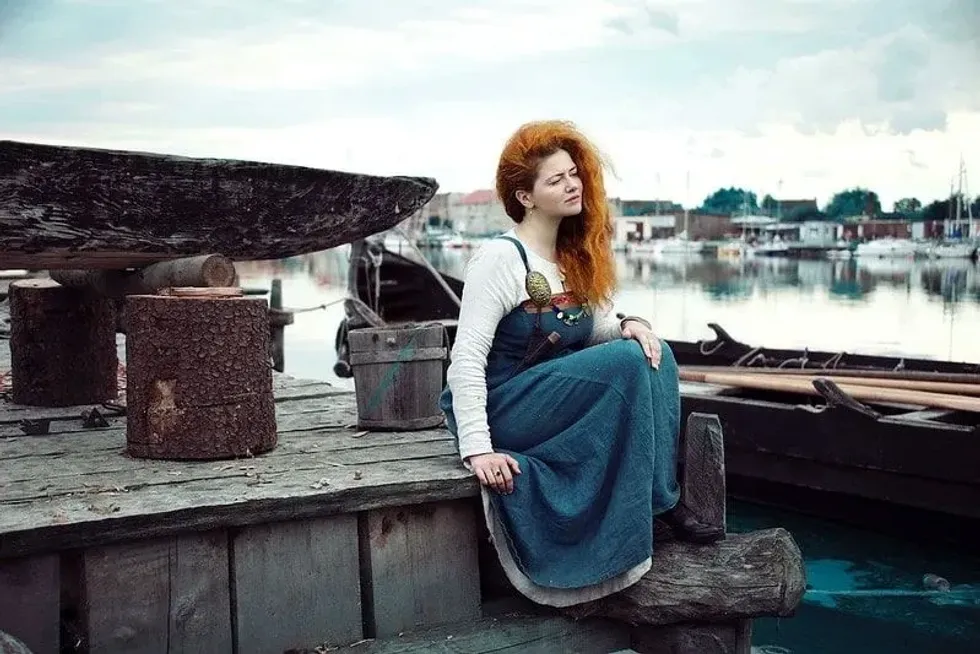Photo by Liliya Grek on Unsplash.
As part of the KS2 History curriculum, children explore British History, from the Stone Age to the struggle for power between the Vikings and Anglo-Saxons.
The Vikings were a people from the South of Northern Europe (Denmark, Norway and Sweden) who raided and traded all over Europe from the late 8th to the late 11th centuries.
In Britain, the first invasion was in AD 793 and the last in 1066. The Battle of Hastings put a stop to Vikings’ raids, but the Vikings had won! The Normans (Norsemen) conquered the British Isles in 1066. Coming from Normandy in Northern France, the Normans were descended from the Scandinavian Vikings and changed Britain forever.

Image © Max on Unsplash
Viking Clothes Facts
Viking Men
Viking men wore a linen shirt and a woollen tunic, called a “kyrtill.” Decorations could be found on the high neckline, hem and cuffs, usually braids made with dyed wool. The very wealthy might have imported silk to decorate their tunics.
Viking trousers varied by region, with some quite baggy and others tighter. Made of wool, they didn’t have any pockets and were held together by a belt. Everyday items were hung from the belt, such as small leather pouches or knives.
To finish off their outfits, Viking men usually wore caps made of wool or leather.
Viking Women
Viking women wore a long underdress made of linen or wool, with a dress or long tunic made of wool on top. Shorter than the underdress, the long tunic might have looked like an apron, might have had straps and was fastened by brooches.
Woollen cloaks and shawls were worn over the dress. Women wore belts, but unlike the leather of men, theirs were probably made of fabric. Viking women also wore linen headscarves or hats.
Cloaks And Shoes
Both men and women wore a woollen cloak, which was often quite long, reaching below the knee. For winter, the cloak was lined with fur or feathers.
Vikings shoes were made of leather, with goat skin the most common material. The shoes and boots that men, women and children wore were flat and tied with strips of leather. The rich would line their shoes with fur in winter. Everyone else wore woollen socks.
Children
Children wore the same things their parents did.
Warrior
Viking clothes depended on status, and a warrior's protection was no exception. The rich warrior had chainmail, whilst the poor wore padded leather jackets. Helmets were leather or metal.
Materials And Colours
Viking clothing was handmade out of what was available at the times: wool, linen, leather (for belts and shoes) and animal skins, such as bear, marten, beaver, squirrel or fox. Wool and linen were the most common, with animal skins for winter and imported silk reserved for the wealthy and powerful.
Excellent weavers, the women and children made yarn from wool and used natural dyes from plants. Some of the colours produced were beige, brown, red, yellow, gold and blue.

Image © Clem Onojeghuo on Unsplash
What Accessories Did The Vikings Wear?
Most of the Viking accessories were practical: the belts, the pins which kept Viking’s cloaks in place, tunics held by brooches, but it doesn’t mean these were plain.
The pins holding the Vikings’ cloaks together could be made of wood or bone, but the rich had highly decorative ones, some even made of gold.
Viking women’s tunics were held by bronze brooches, which were quite fancy, and made even fancier when glass or amber beads were slung between them. Some women wore brooches attached to chains, with combs, keys or scissors displayed.
Both men and women liked jewellery: copper, gold or silver rings were worn on fingers, arms, and around the neck.
The wealth and status of the Vikings was reflected in their clothing: colourful clothing, imported silks from Asia… when it came to accessories and Viking jewellery, the more intricate and detailed, the wealthier the wearer.
Viking Facts
1. Vikings would loot clothing in their raids. It took a very long time to make anything by hand, so clothes were seen as valued items.
2. Viking dress evolved because of travel! Some of the Viking traders saw what other people wore and it made an impact on their own dress. One example would be how after seeing the Asian style, Viking trousers got baggier.
3. The Vikings wanted to look good and took extra care with their appearances. They ironed their clothes with heated, smooth stones or glass!
4. There is no such thing as a Viking helmet with wings, but there is such a thing as horned helmets. The horned helmets weren’t used for war, however, only for religious ceremonies.
5. Only one complete Viking helmet has ever been found! Passed down through generations, when they got too old, helmets were probably recycled into swords. This is why the one complete helmet found on a farm in Norway is such a treasure.
Fun Activities
Try these fun activities at home to get the kids thinking about clothing from the Viking age.
1. Make a Viking helmet and shield out of cardboard to turn your kids into Viking warriors.
2. Make Viking brooches with the kids: use cardboard for the base and cover in tin foil to replicate silver.










